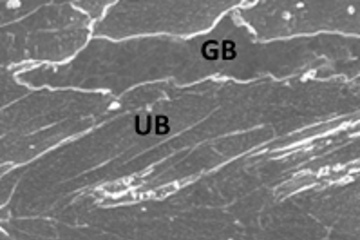All genres
721.
Journal Article
Study of internal stresses in a TWIP steel analyzing transient and permanent softening during reverse shear tests. Journal of Materials Science 45, pp. 6604 - 6610 (2010)
722.
Journal Article
The effect of grain size and grain orientation on deformation twinning in a Fe–22 wt.% Mn–0.6 wt.% C TWIP steel. Materials Science and Engineering A 527, pp. 3552 - 3560 (2010)
723.
Journal Article
Synthesis of hollow metallic particles via ultrasonic treatment of a metal emulsion. Scripta Materialia 62, pp. 690 - 692 (2010)
724.
Journal Article
Orientation dependence of local lattice rotations at precipitates: Example of κ-Fe3AlC carbides in a Fe3Al-based alloy. Acta Materialia 58 (20), pp. 6672 - 6684 (2010)
725.
Journal Article
Second-order convergence of the deviatoric stress tensor in the standard Bhatnagar-Gross-Krook lattice Boltzmann method. Physical Review E 82 (025701) (2010)
726.
Journal Article
Comparison of finite element and fast Fourier transform crystal plasticity solvers for texture prediction. Modelling and Simulation in Materials Science and Engineering 18 (8), 085005, pp. 085005-1 - 085005-21 (2010)
727.
Journal Article
A review of crystallographic textures in chemical vapor-deposited diamond films. Frontiers of Materials Science in China 4 (1), pp. 1 - 16 (2010)
728.
Journal Article
Effect of strain hardening on texture development in cold rolled Al–Mg alloy. Materials Science and Engineering A 527, pp. 1249 - 1254 (2010)
729.
Journal Article
Microstructure and texture evolution in dual-phase steels: Competition between recovery, recrystallization, and phase transformation. Materials Science and Engineering A 527 (16-17), pp. 4161 - 4168 (2010)
730.
Journal Article
Annealing behavior of ferritic–martensitic 9%Cr–ODS–Eurofer steel. Materials Science and Engineering A 527, pp. 3602 - 3608 (2010)
731.
Journal Article
Electron backscatter diffraction study of Nb3Sn superconducting multifilamentary wire. Scripta Materialia 62 (2), pp. 59 - 62 (2010)
732.
Journal Article
Crystal orientation effects in scratch testing with a spherical indenter. International Journal of Materials Research 25, pp. 921 - 926 (2010)
733.
Journal Article
Fast, Physically-Based Algorithms for Online Calculations of Texture and Anisotropy during Fabrication of Steel Sheets. Advanced Engineering Materials 12, pp. 1206 - 1211 (2010)
734.
Journal Article
Plastic anisotropy of γ-TiAl revealed by axisymmetric indentation. Acta Materialia 58 (9), pp. 3516 - 3530 (2010)
735.
Journal Article
Microtexture and Grain Boundaries in Freestanding CVD Diamond Films: Growth and Twinning Mechanisms. Advanced Functional Materials 19 (24), pp. 3880 - 3891 (2009)
736.
Journal Article
Smaller is stronger: The effect of strain hardening. Acta Materialia 57, pp. 5996 - 6005 (2009)
737.
Journal Article
Virtual material testing for stamping simulations based on polycrystal plasticity. Computational Materials Science 46 (2), pp. 383 - 392 (2009)
738.
Journal Article
Effect of aspect ratio on transverse diffusive broadening: A lattice Boltzmann study. Physical Review E 80 (1), pp. 016304-1 - 016304-9 (2009)
739.
Journal Article
Residual stress analysis in chemical-vapor-deposition diamond films. Applied Physics Letters 94 (20), 201902 (3pp) (2009)
740.
Journal Article
Shear stress in lattice Boltzmann simulations. Physical Review E 79 (4), pp. 046704-1 - 046704-14 (2009)











